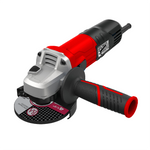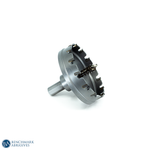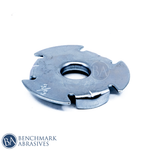
How to Remove Spray Paint from Metal (DIY Guide)

If you've got a metal item buried under layers of old paint—whether it's a vintage find or a DIY project that didn't go as planned—you're probably wondering how to get back to the original finish without causing damage.
The good news is that it's completely doable. From garden chairs to door hardware to automotive parts, you can successfully strip away even stubborn spray paint when you use the right approach for your specific metal surface.
While it might look daunting at first, especially when you're dealing with multiple layers of paint, the process becomes straightforward once you understand which method works best for your material. This guide will walk you through selecting the appropriate paint removal technique for different surfaces, including stainless steel, powder-coated items, and automotive components.
With the right method matched to your project, you can restore your metal pieces to their original condition without the guesswork.
Understanding Different Types of Spray Paint on Metal
Before checking out the methods, let’s have a quick discussion about what you are actually trying to remove. Not all spray paints are the same, and this matters a lot when you're trying to understand the science behind removing them from a metal surface.
Oil-based vs. Water-based Spray Paint
Water-based spray paints are generally easier to remove from metal surfaces because they tend to sit on top of the material rather than adhering strongly. In contrast, oil-based spray paints are tougher and more durable, meaning significantly more effort is required to strip them away from metal.
There is acrylic paint, which is technically water-based but can behave more like oil-based in some conditions, especially once it’s cured on a hard metal surface.
How Does Paint Adhere to Metal Surfaces?
Metal is a non-porous surface, which means spray paint doesn’t absorb into it the way it might get absorbed with wood or fabric. Instead, it clings through surface tension, especially if the surface type has been sanded or primed first. This is why some paint removal methods (like scraping or heat) work better on specific paints than others.
Why Certain Removal Methods Work Better for Specific Paint Types?
Different spray paint types (oil-based, water-based, or acrylic) adhere to metal surfaces in unique ways, affecting how easily they can be removed. Some methods, like solvents, work better on oil-based paints, while gentle scraping suits water-based or acrylic paints.
Knowing which removal methods work better for specific paint types helps you avoid damaging the metal surface. For example, oil-based spray paint is more stubborn and may require chemical strippers, while water-based or acrylic paints need mild scrubbing.
Assessing your paint type saves time, protects the original finish, and achieves the best results.
Preparation and Protective Measures
Let’s not skip over the boring (but super important) stuff. Preparing properly can save you a lot of time and frustration. Taking the right safety precautions is key for a smooth project. Wearing gloves not only protects your skin but also helps you avoid ever having to remove spray paint from your hands.
Some of the paint removal methods involve the use of chemical strippers, which can produce strong fumes. So, make sure your setup is in a well-ventilated area; operating outdoors is a good option. However, if you are working indoors, crack the windows and set up a fan.
When undertaking tasks that involve chemicals, fumes, or debris, it's essential to wear appropriate protective equipment. Ensure you have safety goggles, plastic gloves, a face mask or respirator, and wear clothes with long sleeves.
Protect the Surrounding Surfaces
To keep the mess under control and ensure safety, always prepare your work area carefully. Cover surfaces around your project with plastic sheeting, drop cloths, old newspaper, or cardboard. Use masking tape along edges or areas you want to protect from stripping. Remember, safety is just as important as results. So, use caution and don’t rush through this part.
Non-Chemical Methods for Spray Paint Removal
Not in favor of using harsh chemicals? That’s totally fine. These methods involve manual work and less harsh solutions.
1. Mechanical Removal Techniques
Paint scrapers, razor blades, plastic scrapers, wire brushes, and angle grinders are all effective tools for removing spray paint. Scrapers and abrasive tools are especially ideal for removing spray paint from metal. Use a putty knife or razor blade at a 45-degree angle to avoid scratches. For tough spots, a wire brush or stiff bristle brush is better.
If you are looking to remove paint from delicate surfaces, use a plastic scraper or an old toothbrush for safer results.
To handle scraping tasks, you'll need a range of tools. For general scraping, a paint scraper or a gentler plastic scraper can be effective. A putty knife is versatile for both scraping and spreading. For tougher grime or rust, a wire brush or a stiff brush will come in handy. For flat, stubborn spots, a razor blade offers precision. Additionally, for heavy-duty jobs, an angle grinder is the tool of choice.
To avoid damaging the metal, go slow and steady—don’t rush the removal. Use gentle pressure and hold tools at a 45-degree angle to avoid scratching. Always test your method on a small spot first. For softer metals or detailed areas, choose plastic tools over metal ones to keep the original finish safe and ensure proper removal.
2. Heat-Based Removal Methods
Heat guns offer an efficient way to remove stubborn paint, especially from flat surfaces, when used correctly. Start by setting the heat gun to its lowest setting. The key to effective and safe use is constant motion; never hold the gun in one spot for too long, as this can scorch the metal or surrounding areas.
Once the paint starts to bubble, gently scrape it away. This method produces the best results when combined with scraping, but always exercise caution to prevent overheating or warping thinner metal items.
3. Pressure Washing
Pressure washing is the best way when you're dealing with large, flat metal surfaces. Also, the method is perfect for surfaces like fences, outdoor furniture, gates, or metal siding.
However, a pressure washer technique is not ideal for delicate or detailed items.
Start with a low to medium pressure setting (around 1,500 to 2,000 PSI is usually enough for most metal surfaces) and use a wide-fan nozzle to spread out the force. Always keep the nozzle moving in steady, even strokes and hold it at least 12–18 inches away from the surface. After washing, let the metal fully dry before applying any new finish or paint.
Tips: Always start with low to medium pressure and adjust as needed. Remember, a wide fan nozzle is safer than a narrow one. You also need to avoid using high pressure on soft or thin metal.
Household Solutions for Spray Paint Removal
1. Vinegar Method
If you're looking for a gentle, non-toxic way to remove spray paint from a metal surface, white vinegar is an effective option. It's a common household item, easy to use, and safe for most surfaces.
Step-by-step application process:
- Warm up a small amount of white vinegar; you can do this on the stove or in the microwave. It should be warm water, not boiling.
- Dip a clean cloth into the warm vinegar and apply it to the small area of spray-painted metal you want to clean.
- Let it sit for about 10–15 minutes so the vinegar can soften the paint.
- Once the paint starts to loosen, gently scrub the surface with an old toothbrush or a clean cloth.
- Clean the area with water and a dry cloth to remove any residue.
Soaking vs. direct application
For smaller items, like a metal knob or a painted screw, you can fully soak them in a bowl of warm white vinegar for 30 minutes to an hour. This method allows the vinegar to break down stubborn paint more thoroughly. Once soaked, use an old toothbrush to scrub off the loosened paint.
Direct application can be applied on the larger surfaces, like a metal chair or railing. Soak a clean cloth in warm white vinegar and lay it over the affected small area. Press it in and let it sit, reapplying as needed to keep it damp. After 10–15 minutes, scrub gently with an old toothbrush and clean it.
2. Baking Soda Solutions
If you're dealing with stubborn paint on a metal surface and want a non-toxic, budget-friendly solution, baking soda is a great choice. It does not damage the metal and is still effective enough to help lift old paint.
Start by mixing baking soda with a bit of warm water to form a thick paste. The consistency should be spreadable, like toothpaste, not watery. Apply this paste directly onto the affected area and let it sit for 15–20 minutes. This allows the baking soda to start breaking down the paint.
Scrubbing Techniques
After the paste seems to have worked, grab a stiff brush (a nylon one works well) and start scrubbing the area in circular motions. Pay attention to any spots where the paint is peeling or bubbling; you can wash these off with warm water and repeat if necessary.
This soda solution works best on thinner layers of paint or surfaces that have already been loosened with heat or vinegar. It's gentle, effective, and safe to use on most household metal items.
3. Other Household Products
Sometimes the best paint removers are already in your kitchen or bathroom cabinet. If you’re not ready to jump into harsh chemicals, these common household items can be a good option for cleaning up spray paint on smaller or delicate metal surfaces.
Using Cooking Oils and Dish Soap
Vegetable oil or olive oil can also help soften dried spray paint. Just apply a small amount directly to the painted area and let it sit for 10–15 minutes. Then, scrub gently with a clean cloth or soft brush. This works well on fresh paint or as a pre-treatment before using stronger methods.
For mild cleanup or removing leftover residue, a mix of warm water and dish soap is another simple solution. It won’t strip layers of paint, but can help break down surface oils and loosen flakes on lightly painted items.
Rubbing Alcohol
Rubbing alcohol is especially effective on water-based spray paints. Dip a clean cloth in alcohol and gently rub the painted area. It’s safer for many indoor applications and won’t damage the metal.
You can also try non-acetone nail polish remover, a less harsh alternative to traditional acetone. It's useful for touching up detailed spots or removing paint without stripping the original finish.
These methods may not tackle heavy-duty jobs, but for light or fresh spray paint, they are a good option before trying chemical strippers.
Chemical Solutions for Spray Paint Removal
When non-chemical methods don't work, chemical solutions are effective in removing spray paint from metal surfaces. Here are all the details you need for commercial paint strippers, various solvents and thinners, with tips on application and metal-specific considerations.
1. Commercial Paint Strippers
Chemical paint strippers come in various types, each suited for different applications. Methylene chloride-based products are highly effective for removing multiple layers of paint, though they require proper ventilation and protective gear due to their strong nature.
For smaller areas or light spray paint, graffiti remover is a good choice. After stripping, lacquer thinner is useful for cleaning up any remaining residue. Some common chemical strippers, found in liquid, gel, or paste form, can be found at most hardware stores, like Home Depot.
Follow five simple, easy steps for the application and removal process of a chemical paint stripper.
- First, apply the chemical paint stripper evenly to the painted metal surface using a brush or applicator. Allow the stripper to sit for the recommended time per the manufacturer's instructions until the paint begins to bubble or soften.
- Next, gently scrape the loosened paint using a plastic or metal scraper.
- For stubborn areas, reapply the chemical stripper and repeat the process.
- Wipe down the surface with a lint-free rag dampened with lacquer thinner or rubbing alcohol to remove any residue.
- Rinse the surface thoroughly with water (if recommended) and dry completely.
Metal-specific considerations
When using chemical paint strippers on metal surfaces, it’s important to consider the type of metal. Some metals, like aluminum, if exposed to chemicals for too long, may corrode quickly. Always test the chemical stripper on a small area first to make sure it won't damage or discolor the metal.
2. Solvents and Thinners
Solvents like acetone, rubbing alcohol, and lacquer thinner are commonly used to remove spray paint from metal surfaces. Glass cleaner and stain remover can be effective on smaller areas or light overspray.
Start by applying a small amount of your chosen solvent to a lint-free rag or cleaning pad. Gently rub the affected area until the paint begins to lift, repeating the process as needed for optimal results. Always ensure proper ventilation and wear protective gloves to prevent skin irritation.
Specialized Approaches for Different Metal Types
1. Stainless Steel
Stainless steel is a durable metal with a smooth surface, but its reflective quality requires careful handling. When removing spray paint, choose the best methods that protect the original finish without causing damage. Avoid harsh abrasives and strong chemicals that can harm the steel. For flat surfaces, gentle scrubbing with non-abrasive tools combined with mild solvents often works well.
Avoid using any metal brushes or scrapers that can leave scratches on stainless steel. Instead, use soft cloths or plastic scrapers. If using chemical strippers, select those specifically safe for stainless steel to prevent discoloration. Rinse thoroughly after removal to stop any chemical residue from damaging the surface.
2. Powder-Coated Metals
Powder-coated finishes on metal items create a protective and decorative layer that harsh treatments can easily damage. The best way to remove spray paint from these surfaces is to use gentle chemical strippers formulated for powder coats or mild detergents with careful manual scrubbing. Always use caution and test a small area first to ensure the original finish is not compromised.
It is essential to remember that powder-coated surfaces are sensitive to strong solvents and abrasive tools, causing peeling or dullness. Because the coating is thinner than paint on bare metal, it’s easy to accidentally strip away the powder coat itself while removing spray paint. Patience and light application of paint removal methods are essential to restore your metal's original finish.
3. Automotive Metal Surfaces
Vehicles come with complex layers of automotive paint designed for durability and appearance. Spray paint on a painted area must be removed carefully to avoid damaging the factory finish or commercial paint jobs. This often requires specialized products and techniques suited for automotive surfaces.
Professional vs. DIY approaches
DIY methods are used for small spots of spray paint. In the case of larger areas or delicate finishes, professional help is needed for professional results. Professionals can access hard-to-reach areas and apply paint removal safely without causing further damage. For best outcomes, check the size and condition of the spray paint before deciding on DIY or expert services.
How to Deal with Stubborn Paint and Special Conditions
Removing stubborn paint, especially old paint present on the surface for years, can be challenging. Multiple layers of paint may require repeated applications of removers or a combination of methods. Mechanical scraping and chemical strippers can be used to remove it. But always test a small area first to avoid unnecessary damage. For smaller items, soaking in vinegar or a soda solution overnight can help loosen layers before scrubbing.
Guidelines for intricate metal surfaces
For intricate metal surfaces with a wide range of textures or shapes, extra care is required. Use soft tools like toothbrushes to reach hard-to-reach areas without causing damage. You may also use gentle chemical solutions and thoroughly rinse the surface after stripping paint.
If the metal holds historical or sentimental value, or if it's an older piece with multiple coats applied by previous owners, seek professional help to preserve the original finish.
Fresh Metal and a Fresh Start
The best way to remove spray paint from metal involves choosing a technique that suits the specific paint and metal type. For light paint, household solutions like vinegar or baking soda can be an effective way. For tougher jobs, consider chemical paint strippers or professional services.
No matter which spray paint removal methods you use, always test in a small area, follow guidelines, and wear protective gear for the best results. Good luck with your project!



































































